Hidden away in the rolling hills of Northern Thailand, is the sleepy city of Chiang Rai. It’s most famous for being home to The White Temple, a unique and avant-garde display of art, as well as being the last stopping point before crossing the border to Laos via slow boat.
Although it’s not a big city, nor is it very busy, so many people often wonder; is Chiang Rai worth visiting? The answer depends on what you want to get out of your visit to Chiang Rai.
For those who love modern art and innovative architecture, gorgeous natural scenery, a laid-back atmosphere, authentic Thai night markets, and opportunities to get off the beaten path, Chiang Rai is worth visiting.
But if you’re short on time and you’re still on the fence about visiting, then you might be wondering what makes people want to journey to Chiang Rai.
In this guide, we list the pros and cons of visiting Chiang Rai.
Is Chiang Rai Worth Visiting?
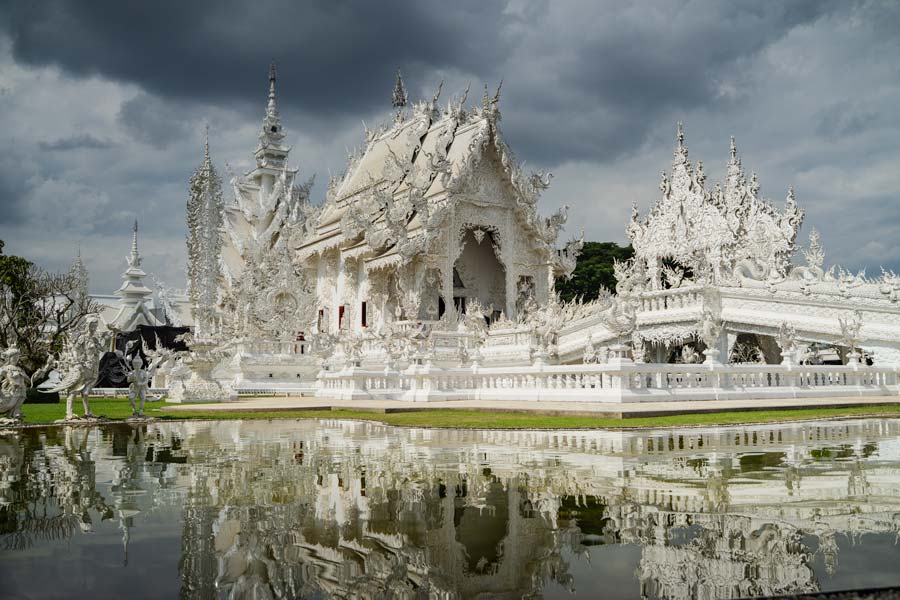
Chiang Rai is definitely worth visiting if you want to see beautiful temples and unique displays of modern art. Located in the north of Thailand, it’s surrounded by lush nature and small hilltribe villages, which are often unexplored by tourists who prefer to explore the surroundings of its neighbor, Chiang Mai.
Those looking to get off the main tourist trail will find some of the best natural scenery in the country just outside of Chiang Rai, from lush jungles and soaring mountains.
Visitors can also experience the world-famous White Temple, which despite its name isn’t so much as a temple but an art installation, created by an artist called Chalermchai Kositpipat who was born in Chiang Rai.
Kositpipat set out on a task to completely rebuild the temple on the grounds of Wat Rong Khun, funding the project himself. He said he wanted it to be a center of learning and meditation, as well as a work of modern art. The temple complex is still ongoing, and he is even training apprentices to take over for him after he dies.
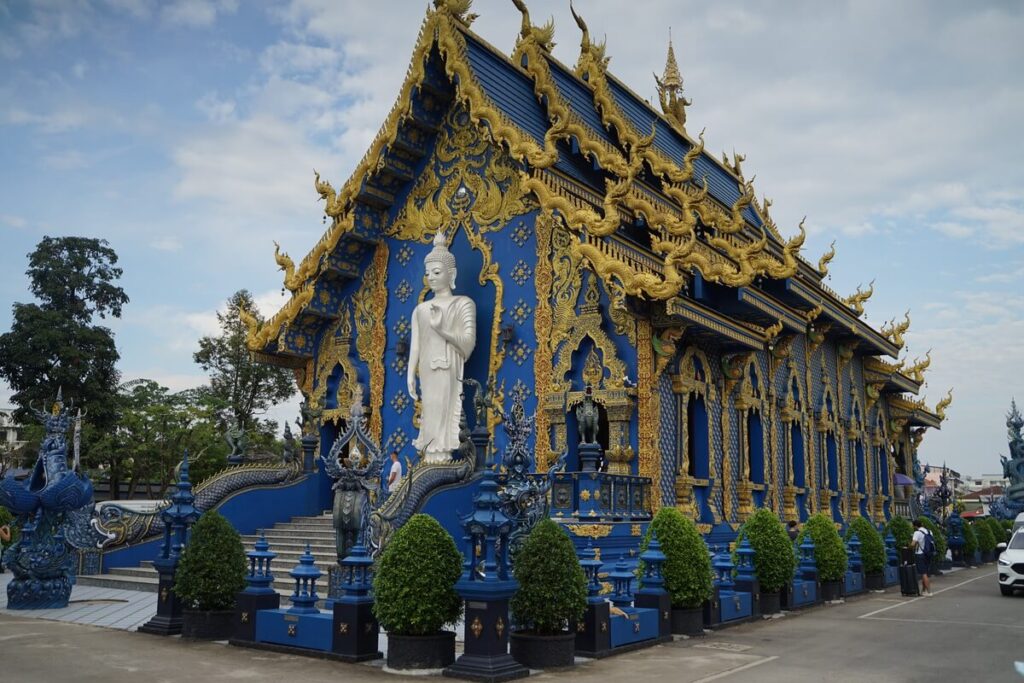
The White Temple is reason enough to visit Chiang Rai as there is no other temple like it, but if you do want to see more modern art, then a visit to Baan Dam Museum, also known as Black House Museum, and Wat Rong Suea Ten, or The Blue Temple, are also homes to unique displays of art.
What sets Chiang Rai apart from the rest of the cities in Thailand is that you can experience an authentic part of Thai culture, with bustling night markets and plenty of traditional Thai restaurants serving some regional favorites, Khao Soy and Masamam Curry.
Chiang Rai is an amazing city with plenty of pros, but there are some cons as well, which we shall discuss later in this guide.
Pros of Visiting Chiang Rai
1. Visit the stunning White Temple (Wat Rong Khun)
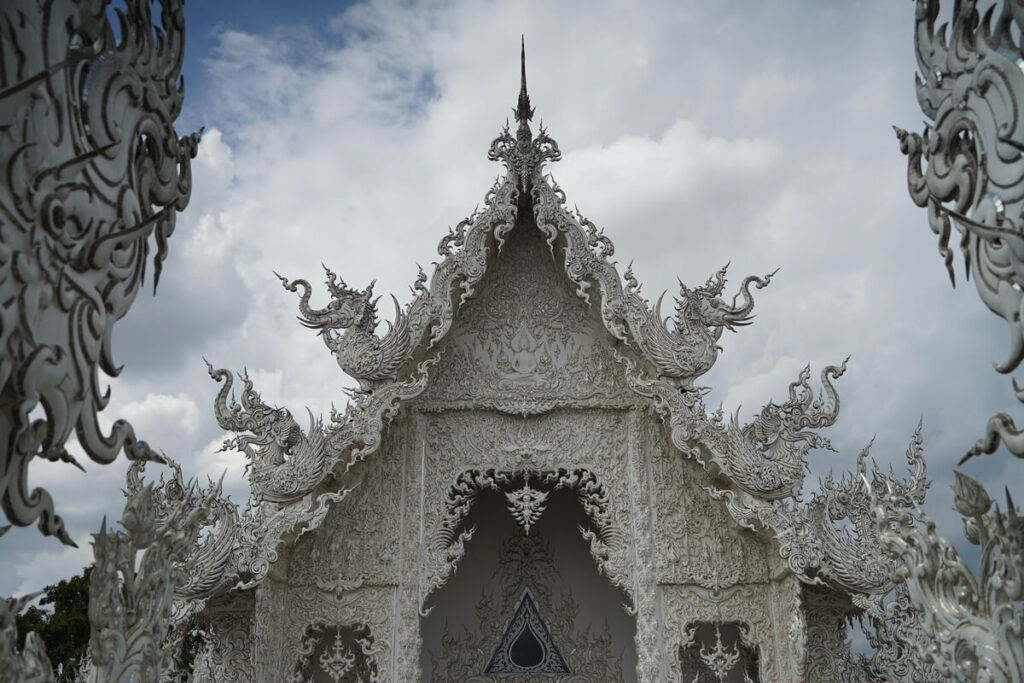
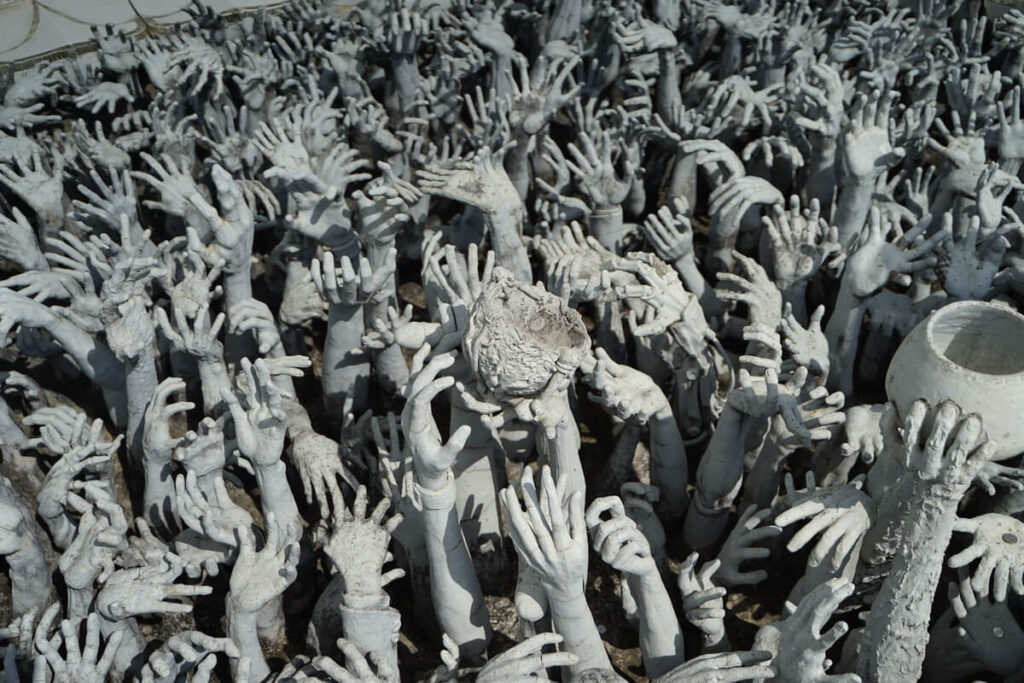
As we mentioned earlier, The White Temple, or Wat Rong Khun as it’s known to the locals, is arguably one of the most famous, and most visited temples in the whole country – and temples are what makes Thailand famous, so therefore its the main reason to visit Chiang Rai.
It is incredibly unique in the fact the entirety of the temple is white, which after visiting plenty of other authentic Thai temples, is incredibly striking.
The White Temple is the brainchild of local Chiang Rai artist Chalermchai Kositpipat, who decided to fund the renovation of the temple out of his own pocket after government funding was simply not there.
If there’s one thing that can be said about the White Temple is that it is a magnificent work of art, with such detail in every element of the building.
To enter the main temple building, you must first have to cross the ‘Bridge of Rebirth’, representing the life cycle of birth, death, and rebirth to enlightenment, which is represented by the temple itself.
Even on the floor surrounding the temple, there’s an intriguing ‘sea of hands’ symbolizing desire and attachment, which is very peculiar to look at.
2. Spend time in the brilliant Blue Temple (Wat Rong Suea Ten)
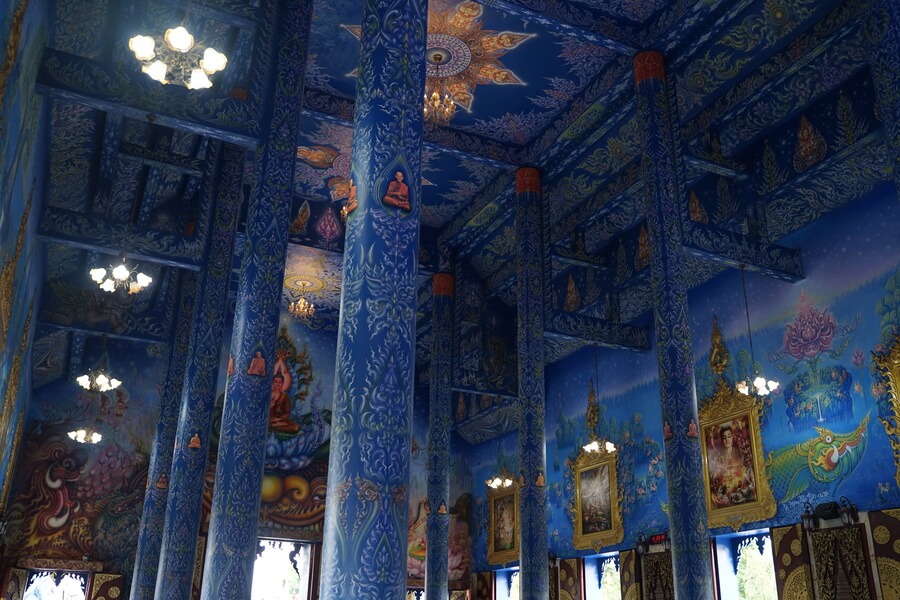
Similar to the White Temple, the Blue Temple (Wat Rong Suea Ten) in Chiang Rai is another temple in Thailand that blends the beauty of modern art with traditional Thai architectural elements.
Replacing an old abandoned temple, the Blue Temple was constructed in 2005 by another local artist Phuttha Kabkaew, who learned his trade from the same artist who created the White Temple just a 15-minute drive away.
The exterior of the temple is an absolutely gorgeous shade of blue, with gold accents throughout, making for a visually stunning temple that really stands out.
The interior is a similar affair, with blue being the main color accentuated with lime greens, pinks, and classical gold. There is a gigantic white porcelain Buddha in the rear center of the temple, illuminated with deep blue lights.
Both of these colored temples are just gorgeous, but I preferred the grandeur of the Blue Temple, and also because it was far less busy.
Regardless, the artistic beauty and uniqueness of both temples are more than worthy of visiting Chiang Rai alone.
3. See three countries at once at the Golden Triangle

The Golden Triangle is an infamous region of Southeast Asia, being the convergent point of the three countries of Thailand, Myanmar, and Laos.
It’s well-known for being one of the world’s largest producers of opium, primarily for use in the heroin trade, fueling the dramatic rise of the drug’s usage across the world.
Since this has become general knowledge, authorities have tried to clamp down on opium production in the area due to the mass tourism that the region sees.
Visitors to the Golden Triangle interested in this fascinating, first-hand insight into something so illegal can visit the Hall of Opium Museum which is just a short distance up from the viewpoint.
Aside from the illegal trade that makes the area famous, the scenery in this part of the world is spectacular. Rolling hills for miles, the fast-flowing Mekong River, and it is one of the few places in the entire world where you can see three countries at once.
4. Visit the weirdness of the Black House (Baan Dam)
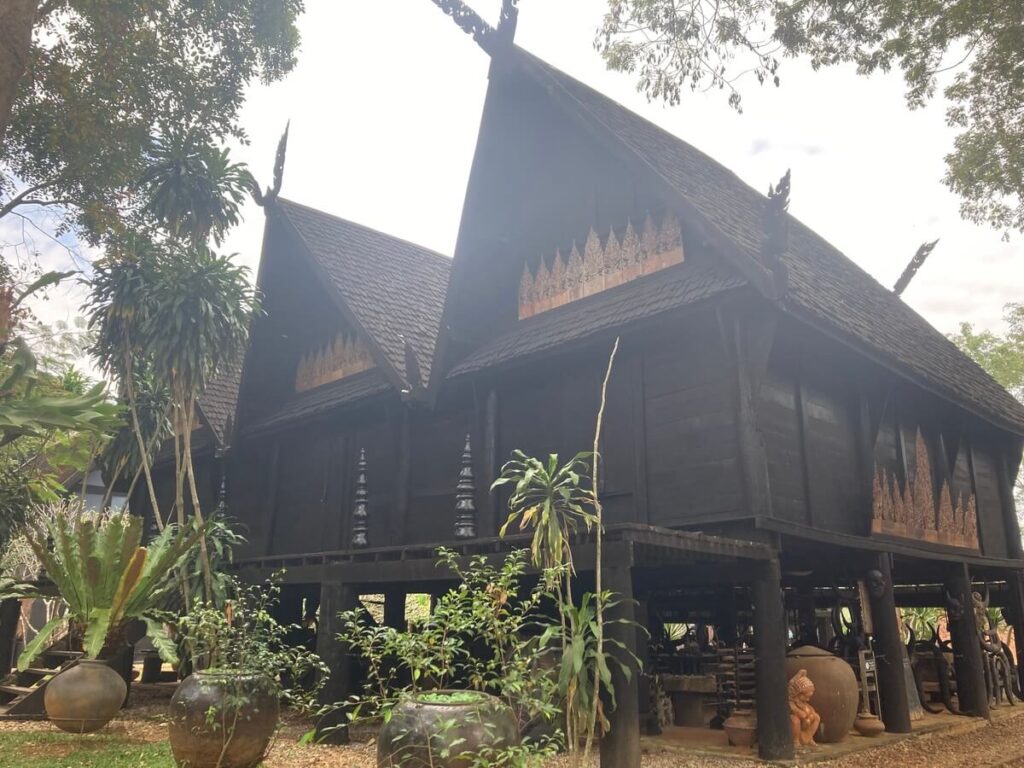
One of the more, shall we say, interesting things to do on any visit to Chiang Rai is to head over to the very intriguing ‘attraction’ of the Black House (Baan Dam).
Set in what looks like a collection of dark, old wooden buildings is the mysterious collection of sculptures, taxidermy, artworks, and artifacts collected by a local artist named Thawan Duchanee.
Some of the artwork displays have a particularly, phallic style, and are said to be a symbol of fertility in Thai culture
Not only is extremely unique and rather eerie, but it also provides a stark contrast to the brightness of the White Temple and also the sheer opulence of the Blue Temple.
If you’re a little confused, think of the Black House as a mix between an art studio and a museum, displaying the local architecture of the Northern region spread out across 40 buildings, some built using amazing Thai architecture and also some using more modern techniques.
5. Connect with indigenous Hill Tribes

Chiang Rai and the surrounding region are a far cry from the chaos of Bangkok or the hustle and bustle of any other large tourist-focused town or city in the country.
As we’ve already spoken about, northern Thailand is practically a world away from those places. Hundreds of miles of untouched jungle and rainforest, empty roads that stretch for miles without ever driving past another car, and tucked-away villages home to semi-indigenous hill tribes like the Karen and Hmong.
If you enjoy seeing the true version of a country, then booking yourself onto a hill tribe tour is one of the most rewarding experiences you can have in the area.
You’ll be able to get well and truly off of the beaten track and witness the real northern Thailand, observing and interacting with friendly locals, and exploring rural areas that rarely ever see foreign faces.
With an expert guide, you’ll be able to hear stories about daily life in these remote areas, dive deeper into the local culture, and even cook an authentic village lunch using fresh ingredients and indigenous cooking techniques.
Not only will you get to experience this once-in-a-lifetime opportunity, but you’ll also contribute to the local community by generating income for the locals directly.
6. Chiang Rai Saturday Night Market
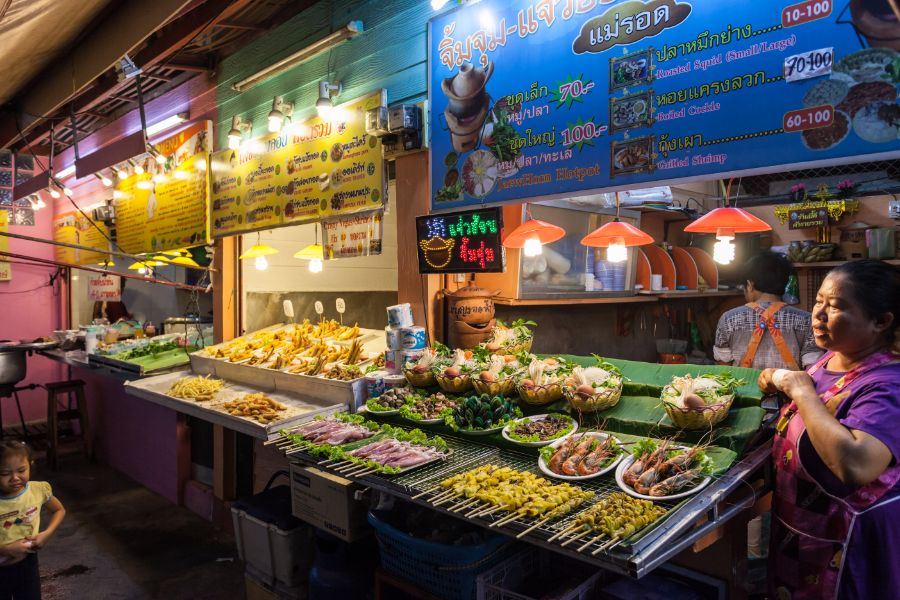
If you’re thinking of visiting Chiang Rai, then whatever you do, make sure you plan it so you coincide your trip with a Saturday night.
We love the Thai night markets and rather unexpectedly found out that the Saturday night walking street in Chiang Rai is arguably one of the best in the entire country.
With a cross shape for design, four of Chiang Rai’s busiest roads are completely closed off to traffic.
It’s then transformed into a gigantic night market with hundreds and hundreds of stalls selling everything from vintage clothes, knock-off designer clothes, bags, souvenirs, and jewelry, and that’s before you even get to the road completely dedicated to street food!
It’s an absolute feast for the senses with huge cauldrons of curry bubbling away, blisteringly hot woks stir-frying noodles, and the whizz of blenders pulsing up fresh fruit for smoothies.
As well as being gigantic, it caters primarily to locals which is great for that true, authentic experience that you won’t find in other larger cities.
There’s also a large open square which often features performances from local bands on the stage for you to sit and enjoy with your food.
Because of the market’s sheer size and popularity, every local and their dog comes out for the Saturday night market so expect things to become incredibly busy by 8.00pm.
7. Visit the famous Tham Luang Cave
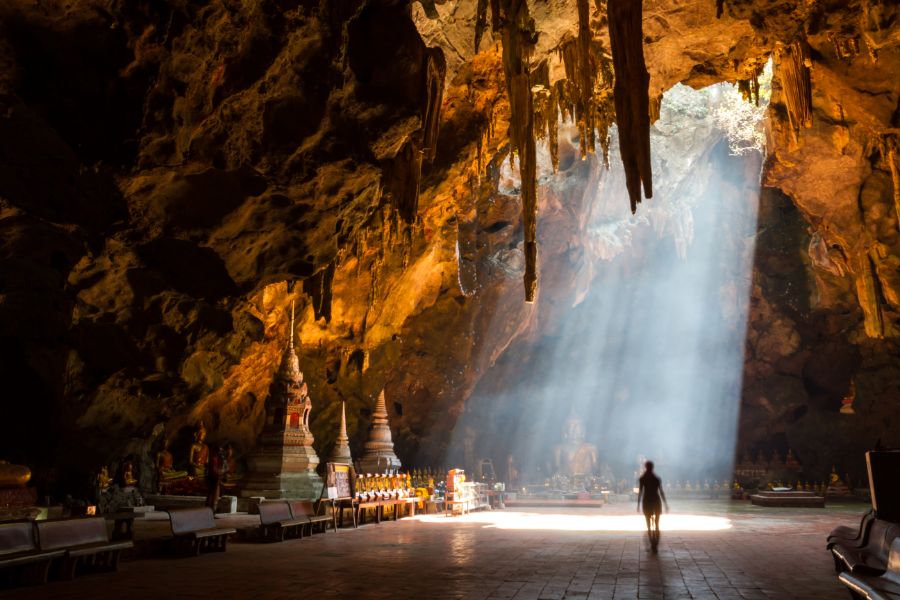
Tham Luang Khun Nang Non, or in English, the Great Cave of the Sleeping Lady is the cave right along the Myanmar/Thai border which gained worldwide attention following the extraordinary rescue mission of the 12 Thai football players and their coach.
They became trapped deep inside the cave complex following intense rainfall and flooding. Unbelievably, the ‘Wild Boars’ team survived for over two weeks deep inside with no light, no food, and no water.
After the alarm was raised, a team of Thai and international experts, including the Thai Navy SEALs, strategically planned how best to get them out safely amid the incredibly intense mountainous monsoon rains.
Miraculously, all 12 boys were successfully rescued along with their coach, however during the rescue attempt a brave Thai Navy SEAL lost their life.
Today, the cave complex is open to visitors, though you can only venture into the first chamber which is still incredibly impressive.
There are several informative displays detailing information on the rescue and the seemingly impossible techniques used to save the boys.
Aside from being the destination of the rescue, the cave site allows visitors to experience the natural beauty of the cave and gain a first-hand understanding and appreciation for everyone who was involved.
Entry is free into the cave and you also get a shuttle bus which takes you to the entrance making it a worthwhile detour if you’re in the Chiang Rai area.
8. To get the slow boat to Luang Prabang
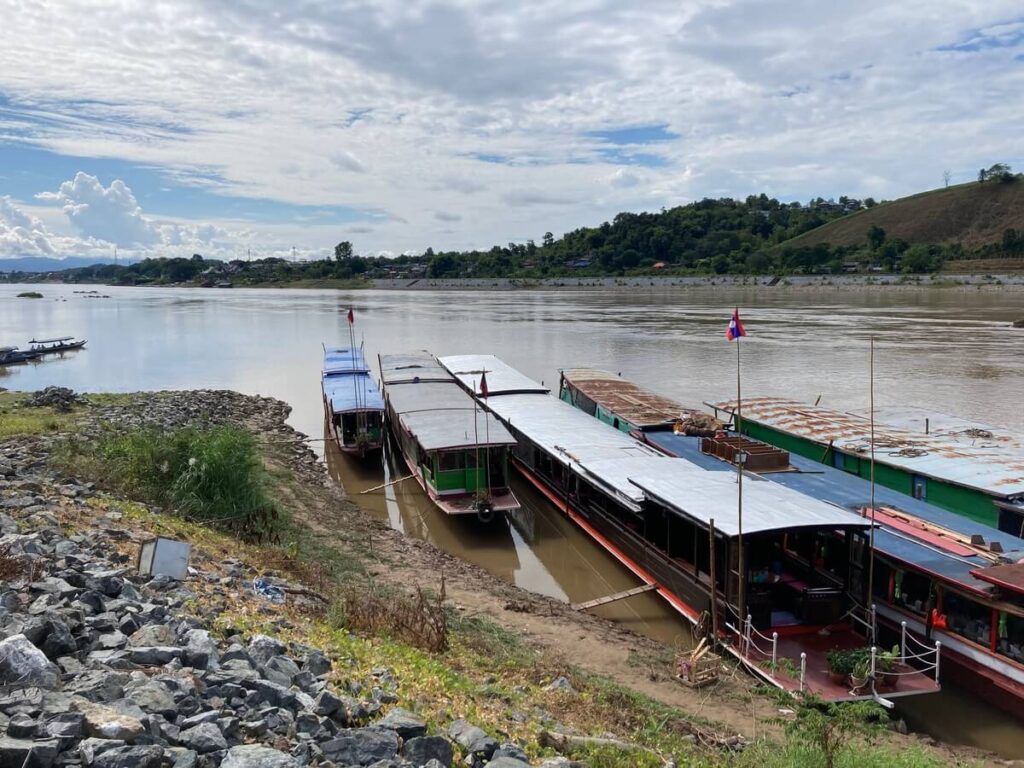
Getting the slow boat from Chiang Rai to Luang Prabang in Laos was one of our favorite travel experiences.
For two days, you are completely cut off from all communication and the internet, and you get to sit back and relax, play card games, drink beer, and share travel stories with other travelers.
The journey itself is tranquil, as you slowly meander down the Mekong River on a long-tail wooden boat, stopping for one night in a remote village in Laos.
It’s the best way to cross the border and reach the beautiful city of Luang Prabang, though not many travelers take the boat the other way towards Chiang Rai, so this would be an entirely different experience.
Cons of Visiting Chiang Rai
1. Not much to do for more than a few days
Chiang Rai is worth visiting but you honestly only need 2-3 full days to see it all. It’s very small and compact, which means you can rent a scooter and drive to all the attractions within one or two full days.
One of the big draws to Chiang Rai is the chance to relax and get off the beaten path a bit, but if you’re not into that kind of travel and you prefer to visit tourist attractions, then you may only want to visit for one full day – and given that it’s a 3 hour bus journey from Chiang Mai, you may not think it’s worth it.
2. Limited Nightlife and Entertainment Options
For those looking for a vibrant nightlife and a wide range of entertainment options, Chiang Rai falls short.
Unlike its neighboring city, Chiang Mai, which offers bustling night markets, lively bars, Thai boxing matches, and cultural shows, Chiang Rai’s nightlife scene is relatively modest.
If you’re seeking a city that never sleeps, you may find other Thai destinations more to your liking.
3. Few Iconic Landmarks
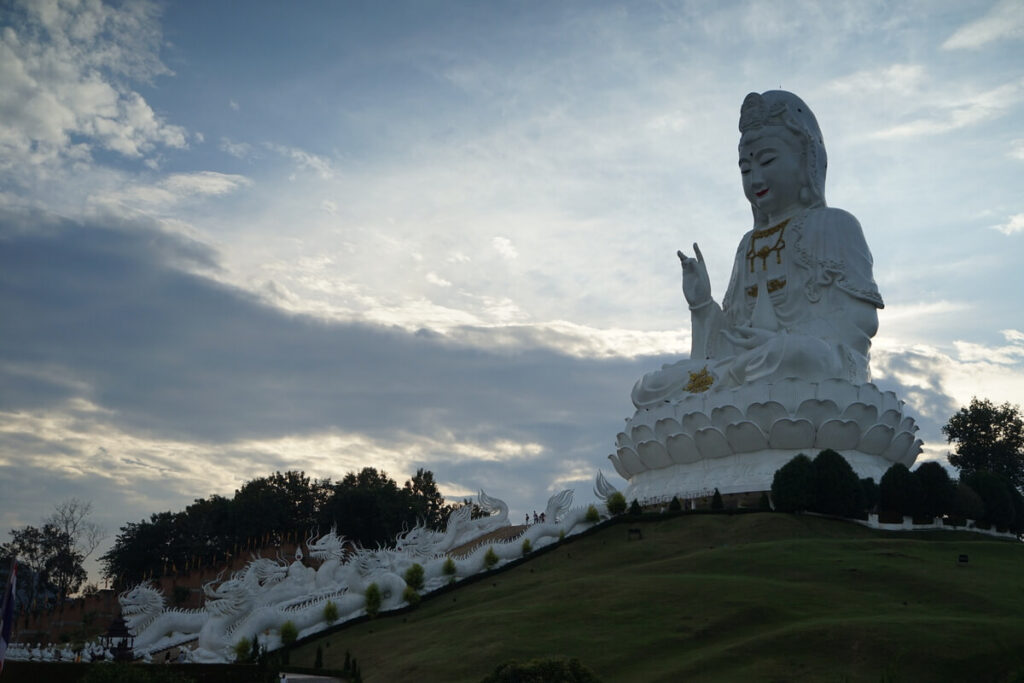
While Chiang Rai boasts a handful of unique temples and landmarks, it lacks the iconic sites that draw tourists in large numbers.
The White Temple (Wat Rong Khun) is undeniably stunning, but there are fewer monumental attractions compared to other Thai cities.
If you’re looking for a destination in Thailand famous for its landmarks, you may consider exploring other regions of Thailand.
4. Limited Shopping Opportunities
Chiang Rai may not be the shopping paradise that avid shoppers dream of. The city’s markets offer a more localized experience, with fewer options for international brands and luxury goods.
If your travel wishlist includes extensive retail therapy and bargaining for designer items, you might be better off exploring the shopping meccas of Bangkok or other major cities.
Final Thoughts
If you’re weighing up a visit to Chiang Rai, then we hope this guide helped you decide whether it’s worth a stop on your itinerary.
We personally really liked Chiang Rai, full of captivating and unique temples and a chill vibe, but we do accept that there is not a whole lot to do, and for some people that may be a deal breaker.
Ultimately, whether you decide to add Chiang Rai to your itinerary will largely depend on how much time you have to spare and your love of modern art.

Are the places mentioned relatively easy to visit if one uses either a walking frame (flat surfaces preferred, not too many steps or a walking stick?
How does one reach there from Bangkok? Any tour arrangements Bangkok?
What is the best time to visit?
Can one organise these visits from the hotel? This information is on a link to the Marriott Hotel.
I’m interested in the hill tribes cultures & being somewhat off the beaten tracks, away from big crowds.
Hi Frances, most of the attractions you can see in with a walking frame. The temples would be doable as they are mostly flat, with a few steps to enter the temple (but not too many). The only attraction I can think of that might be difficult is the Big Buddha because there are a lot of steps up to the Buddha statue. There is a tour you can do to visit the Hill Tribes, which would be your best bet to get off the beaten path if you have mobility issues. The tour picks you up and drops you off at your hotel, and there isn’t much walking throughout the day. You can view information about this tour here. To get to Chiang Rai from Bangkok, we suggest you get a domestic flight from Bangkok to Chiang Rai. You can then get a taxi to your hotel, or you can pre-book an Airport Transfer here. Most tours start from Chiang Rai so it’s better to make your own way there and book onto tours from the city. Most hotels have tour desks where you can book tours if you prefer to be more flexible.